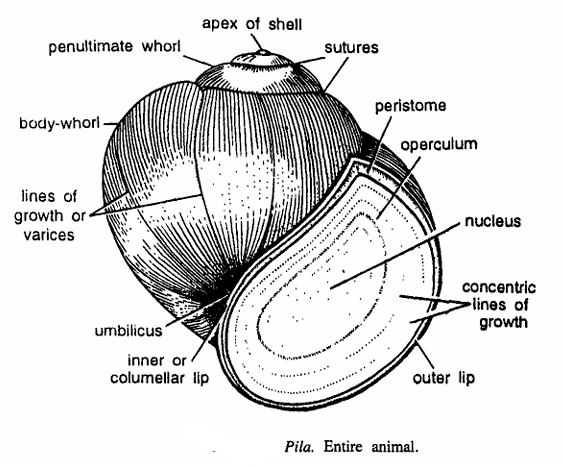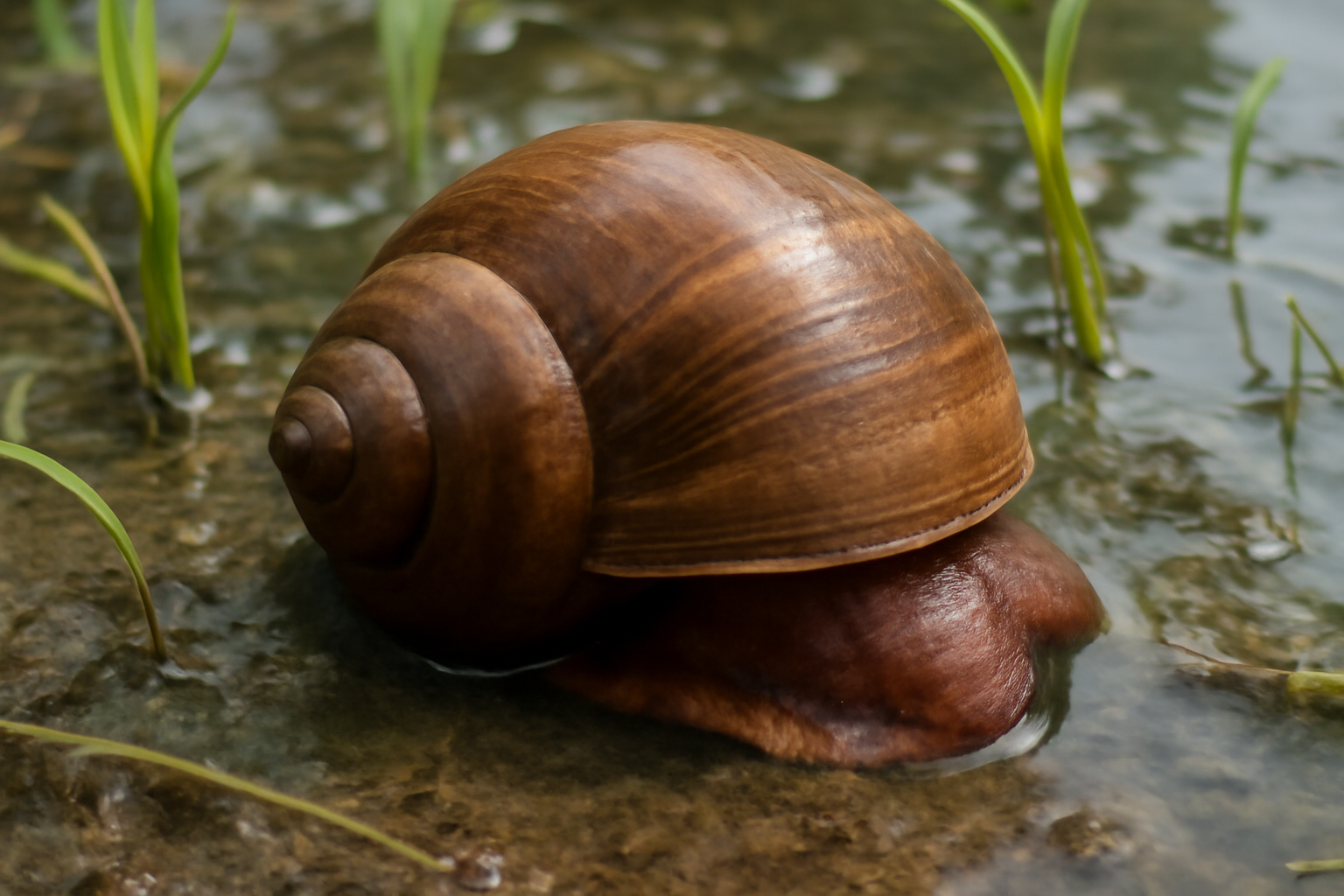Pila globosa: Morphology, Classification, Habitat, and Ecological Role of the Apple Snail
Pila globosa, commonly known as the apple snail, is a freshwater gastropod mollusk belonging to the family Ampullariidae. These snails are recognized for their large, globose shells resembling an apple, and their ecological adaptability to a variety of aquatic habitats including ponds, lakes, streams, and rice paddies. Pila globosa is notable for its dual respiratory system, with gills and lungs, enabling it to thrive in diverse environmental conditions, including periods of drought through aestivation. This species holds importance in aquaculture, local food systems, and freshwater ecosystem dynamics.
Classification of Pila globosa
| Taxonomic Rank | Name | One-line Characteristics |
|---|---|---|
| Kingdom | Animalia | Multicellular eukaryotic organisms |
| Phylum | Mollusca | Soft-bodied animals with a muscular foot |
| Class | Gastropoda | Snails and slugs with coiled or uncoiled shells |
| Subclass | Caenogastropoda | Diverse group of marine and freshwater snails |
| Order | Architaenioglossa | Freshwater snails with gills and lungs |
| Family | Ampullariidae | Apple snails with operculum and amphibious adaptations |
| Genus | Pila | Large freshwater apple snails with globose shells |
| Species | Pila globosa | Freshwater snail adapted to aquatic and terrestrial environments |

Habit and Habitat
Pila globosa inhabits freshwater ecosystems such as ponds, lakes, slow-moving streams, and rice paddies across India, Bangladesh, Sri Lanka, and parts of Southeast Asia. The snail is amphibiotic, capable of both aquatic and terrestrial survival, particularly during dry seasons when it buries itself in mud and enters a dormant state called aestivation.
It seeks habitats rich in aquatic vegetation and organic detritus, which constitute its primary food sources. The species can respire using both gills and lungs, an adaptation that permits survival in oxygen-poor water or on land for short periods.
Geographical Distribution
Pila globosa is native to South and Southeast Asia, broadly distributed in India, Bangladesh, Sri Lanka, Myanmar, and neighboring regions. It thrives in tropical freshwater biotopes but can also withstand varying climatic conditions, including drought by aestivation.

General Characteristics
- Commonly called as fresh-water apple snail.
- Body is covered by a thick yellow-coloured or brown globular univalve shell, comprising of body whorl, penultimate whorl and apex. Each division is separated by sutures.
- Surface of the shell is marked by lines of growth.
- Shell is spirally coiled round the axis, called the columella, and opens to the exterior by mouth of aperture.
- Type of coiling is right handed and is called as dextral.
- After removing the shell the soft part contains head, foot and visceral mass.
- Mouth of the shell is wide and covered by operculum, which is attached to the hinder part of the foot and shows many concentric rings of growth around nucleus, umblicus and columellar lip are closely placed.
- Head lies on the upper side and contains 1 pair of eyes. Foot is highly muscular and acts as creeping organ.
- Visceral mass spirally coiled and contains internal organs.
- It is covered by mantle or pallium.
- When the foot is protruded during living condition, the head, nuchal lobes, eyes, tentacles, etc. are distinctly seen. These structures are seen after removing the shell.
- Sexes are separate but without sexual dimorphism.
- Shell: Large, globose or ball-shaped, somewhat turbinate, and solid with longitudinal striations and green or brown spiral bands.
- Size: Shell diameter ranges typically between 5 to 7 cm, with some larger specimens.
- Body: Soft, unsegmented with a distinct head bearing two pairs of tentacles and eyes at the base of the longer tentacles.
- Foot: Broad, flat, ventral, and almost triangular, facilitating mobility and attachment.
- Operculum: Calcareous trapdoor attached to the foot, sealing the shell aperture when retracted.
- Respiration: Dual system with gills for aquatic respiration and a lung for aerial breathing.
- Feeding: Herbivorous, scraping algae, and consuming aquatic plants and detritus.
- Reproduction: Sexual reproduction with internal fertilization; lays gelatinous egg masses on moist surfaces.
Special Features
- Dual Respiratory System: Gills enable underwater respiration; lung allows breathing air during periods of low oxygen or drought.
- Aestivation: Ability to survive dry periods by burrowing into mud and slowing metabolism.
- Operculum: Protective feature preventing desiccation and predation during dormancy.
- Camouflage: Shell coloration and bands offer camouflage within muddy and vegetated aquatic habitats.
- Nutrient Cycling: Plays a significant role in decomposing organic matter and nutrient turnover in freshwater ecosystems.
- Economic Use: Valued as food in some regions, contributing to local economies and aquaculture.
Identification
Identification relies on:
- Shell morphology including size, shape, and pattern.
- Operculum structure.
- Anatomical features like tentacle arrangement and foot shape.
- Habitat preference and geographical occurrence.
- Molecular tools increasingly support species distinction within Ampullariidae.

Life Cycle and Reproduction
Pila globosa is dioecious, with separate males and females engaging in mating on moist substrates near water. Fertilization is internal, and females lay gelatinous clusters of eggs above the waterline on vegetation or other surfaces.
The eggs hatch into juvenile snails that descend into the water. Growth is relatively rapid under favorable conditions, and the species exhibits a lifespan of several years. Reproduction is strongly seasonal in response to environmental cues such as temperature and rainfall.
Ecological Role and Importance
- Herbivory: Regulates aquatic plant and algal growth, influencing freshwater community structure.
- Ecosystem Engineer: Bioturbation and detritus processing improve sediment quality.
- Food Source: Preyed upon by fish, birds, and mammals, integrating into aquatic food webs.
- Indicator Species: Changes in population density may signal ecological shifts or pollution.
- Human Use: Harvested for food; in some areas, it is considered a delicacy and used in traditional medicine.
Check sources
- https://en.wikipedia.org/wiki/Pila_globosa
- https://byjus.com/biology/pila-globosa-diagram/
- https://www.geeksforgeeks.org/biology/pila-globosa-diagram/
- http://www.molluscabase.org/aphia.php?p=taxdetails&id=842943
- https://www.geeksforgeeks.org/biology/pila-classification/
- https://www.mindat.org/taxon-5783757.html
- https://byjus.com/biology/pila/
- https://en.wikipedia.org/wiki/Pila_(gastropod)
- https://www.sealifebase.se/summary/Pila-globosa.html
- https://www.inaturalist.org/taxa/109512-Pila-globosa
